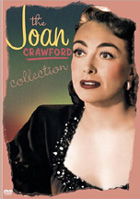 BUY IT AT AMAZON: CLICK HERE!
BUY IT AT AMAZON: CLICK HERE!
STUDIO: Warner Bros.
MSRP: $34.94 RATED: NR
Joan Crawford has a very distinct visage. Much like her feudal counterpart Bette Davis (and her freakishly huge eyes), she’s unique, drawing you in while on screen. Her high eyebrows, her eerie painted lips, her white complexion, all contributed to the look of "The Crawford", a career in which spanned some 40+ years (even Spielberg worked with her!) and included a series of ups and downs that would drive many people mad. Crawford helped to reinvent herself many, many times (having somewhere in the neighborhood of 04+ career revitalizations) going from the depths of box-office poison (something Katherine Hepburn knew all-too well) to the darling of the Academy, winning for Mildred Pierce, which is included in the boxed set.
It took Crawford a while to perfect her on-screen persona (she languished in the background in the late twenties at MGM under her real name Lucille Fay LeSueur), but once she did, she took off, only to fall, and then rise again multiple times in a career spanning some amazing films and some stinkers scattered around the road like duds in wartime. It was during one career slump that she promptly fled to Warner Brothers from her home base at MGM and quickly started up a feud with self-proclaimed Queen of the Burbank lot, Ms. Bette Davis (read Eileen’s DVD Review of The Bette Davis Signature Collection here!). See, Crawford wanted to muscle her way into the house that Bette help build, and saw the top as her place to be. Working hard, diligently, and swiftly, she efficiently saw to it that she would go out for the same types of roles, against the same leading men, with the same goals in sight. It infuriated Davis to no end, much to Crawford’s pleasure. They hated each other from the get-go. Crawford had that effect on people, especially wire hangers.
In all of this, the point being, is Joan Crawford as viable today as she was in earlier years? Definitely. Her films in the Collection Boxed Set are terrific yarns, spilled out against multiple backdrops of pain, pleasure, and noir. If you’re new to older films in general, this set is a great place to start, and then to branch out from afterwards. If you’re the type of person who dreads older more staid films, preferring the more colorful films of today, I’d suggest at least discovering where the films you’re watching currently came from. To be clichéd about it, you’ve got to know where you came from to understand where you’re going.
The Joan Crawford Collection is a terrific boxed set from the fine folks at Warner Brothers, who keep continually knocking their older films out of the park, at very affordable levels. Onward!

The Flicks
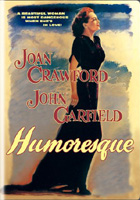 BUY IT AT AMAZON: CLICK HERE!
BUY IT AT AMAZON: CLICK HERE!
STUDIO: Warner Bros.
MSRP: $13.98 RATED: NR
RUNNING TIME: 125 Mins. (B&W)
SPECIAL FEATURES:
• A New Featurette: The Music Of Humoresque
• Theatrical Trailer
Note! This DVD is part of The Joan Crawford Collection (buy the boxed set and save money from CHUD!)
Humoresque (1946)
Crawford doesn’t show up until 33 minutes into the film, so it’s fitting that John Garfield has to pick up the slack (that sonofabitch!), keeping you involved as the virtuoso violinist (and all-around hard worker) Paul Boray. Garfield is the young immigrant kid who is instantly drawn to the violin at an early age (and is played by Robert Blake before sprouting into an acquittal), which, much to the dismay of his spectacled father, becomes his sole purpose for existing. Boray struggles with friend, piano compatriot, and regular comedic relief of Sid Jeffers (Oscar Levant), the type of friend you want around to crack wise and always manage the snarky comment (Wiskerando and R-LU!) in between aiding you with the social and monetary problems of the Great Depression (FDR!). It’s during a party Boray attends where he is locked into Helen (Crawford) Wright’s white-hot intensive gaze. The only minor complication is that Wright is more than married, chained to her husband actually, and she’s more than well-known for her various social taboos that she continually smashes to huge slimy sexual bits. All right within the knowledge of her doting husband (who’s really a throw-away character).
Wright is instantly smitten by Boray’s charm and lack of sophistication. He’s in it for the music and the throngs of people listening to his prowess. Fame seems to be just about the last thing on his mind, however good it could taste. Wright decides to take him in under her all-engulfing wing, one fraught with danger, a little bushy lip action, and of course, ramifications that threaten to tear down everything and she and he have worked so hard to build up over time. The stakes are big, "this isn’t a two hour trip to Chinatown, this is for life" she states, so it’s fitting that everything immediately be thrown into a tail-spin when Wright appears to get a little too friendly with Boray, all in front of Jeffers, his parents, and oh, did I mention her husband, whom she’s still married to? Just another day in paradise, Phil once said.
It’s when Garfield continually digs himself in deeper and deeper with his skewed relationship with this married manmeat-grinder that emotions run the gamut from both sides. Love, in this case, is the only casualty, as it proceeds to mow down everything in its slimy little path, all the way to the point where the two must decide how to move on and then go from there. Humoresque contains a big whopper of an ending, and in fact, was a little shocking (watered down?), but it fits, and works as a whole against the whole gigantic backdrop of the pair’s tumultuous times together.
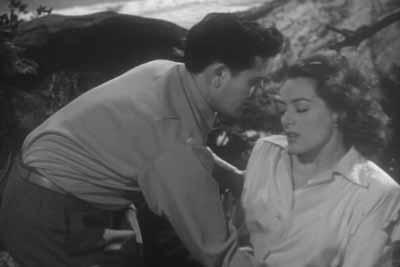
"It’s people! It’s people!"
"What?"
Primary credit has to be ultimately given to the musical genius Franz Waxman, who throws everything but the kitchen sink at you aurally (and is possible he used even that). His score is almost wall-to-wall (which is not uncommon in those days, unlike today), and it works in tandem with the imagery and character developments on screen. His use of violin scores, solos, and using the music as its own character in the film is marvelous to behold, allowing the aural aspects of the film to permeate every frame and underscore emotionally and psychically what you’re viewing on screen. It’s terribly effective and a masterwork of sound to back up the imagery. If you’re wondering how Garfield could play the violin like he does, that’d be movie magic! Huzzah! He’s got someone behind him to do the bow work and someone to his side to finger the strings. As for the imagery, let’s just say it’s spectacular, amazing, and splendiferous, containing a series of sweeping shots that are breathtaking and wondrous to behold. Then, we’ll leave it at that.
Crawford’s performance is a force of nature. She’s introduced wearing white in a sea of black-clad tuxedos, so immediately, you know she’s something to be reckoned with. Here she portrays a woman driven by love and desire, without any thought to the ramifications that it has caused previously in other one-night stands and towards the future rocky seas ahead with Garfield and his rather large appendage, his violin. As the walls close in on her, Crawford allows the character to see the error of her previous discretions, and it seemingly kills her, inside and out. It’s certainly not one of her very best portrayals, but it’s a damn fine study into the mind of a woman I could see Crawford knowing a lot more than she cared to mention.
Humoresque is a great film about two cracked lives who mess each other up something fierce. It’s melodrama at some of its over-the-top best, so check it out. You won’t be sorry. Unless there’s drinking and a hangover involved.
8.5 out of 10
The Look
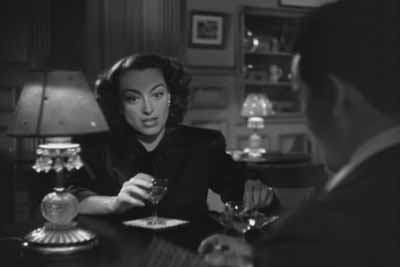
"Pardon me, but I do believe your tube sock is going somewhere it shouldn’t!"
It’s not a bad transfer, but it’s not pristine either (it appears a little dull and has some strobing). However, it works and doesn’t diminish the amazing cinematic feats achieved by workman director Jean Negulesco (How To Marry A Millionaire, Three Coins In The Fountain) and cinematographer Ernest Haller (who also did the spectacular Rebel Without A Cause).
8.0 out of 10
The Noise
Waxman’s score shines through all of your one audio channel (the film is in Dolby Digital 1.0 Mono), but I’d be damned straight to Hades to say that it isn’t a fine piece of work Warner has done to allow the music and other aural sounds to float around your room all butterfly-like and sting you like a crystal clear bee.
9.5 out of 10
The Goodies
The theatrical trailer (runtime: 02:37), which is adequate and informs you all the information that you need to know. Because the more you know makes you wise. And it should sufficiently salivate you into watching the film (and using more s’s when you type).
A new featurette: The Music Of Humoresque (runtime: 09:14), in which several film historians and one master violinist recount the amazing ways Waxman’s score has made the film and the interplay of characters and music. The interviewees go into depth against Waxman’s score as a character in the film (agreed) and the use of the Carmen fantasy versus the nature of the narrative development in the film. It’s a short, but relatively sweet feature and sound make you smarter should you choose to learn. Learning is fun!
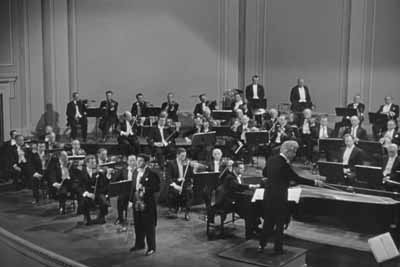
"Good Evening Cleveland! ARE YOU READY TO ROCK?!?"
There aren’t many goodies, so it boils down to if you like goodies or not. I do like goodies, and am a little disappointed. However, what you get is what you get, so I give the extras –
7.0 out of 10
The Artwork
An original poster/print of the film. Fitting. Having not known anything about the film previously, the artwork was my gateway into the film’s psyche, and it’s adequate enough to make me interested, a simple and plain image or not.
7.5 out of 10.0

 BUY IT AT AMAZON: CLICK HERE!
BUY IT AT AMAZON: CLICK HERE!
STUDIO: Warner Bros.
MSRP: $13.98 RATED: NR
RUNNING TIME: 108 Mins. (B&W)
SPECIAL FEATURES:
• Commentary By Film Historian Dr. Drew Casper
• A New Featurette: Possessed: The Quintessential Film Noir
• Theatrical Trailer
Note! This DVD is part of The Joan Crawford Collection (buy the boxed set and save money from CHUD!)
Possessed (1947)
Shocking to audiences of the day was the sight of Crawford (playing Louise Howell), badly in need of some makeup and a Titanic-sized nap, wandering the hazy early morning streets of Los Angeles moaning "David, David…" That is, until she’s thrown into a psychiatric institute. While there, she becomes embroiled in a catatonic stupor the likes of which appear so powerful, even the fake actor-ly doctors overlooking her are at odds what to do. Eventually, she starts blabbering again, but it’s up to us to fill in the holes with how she got there. What is going on? This woman, tortured by her inner demons, and her almost complete mutism that has allowed her to disappear, is ready to spill the veritable beans and clue us, the viewers, into her back story.
Segueing into flashback via piano, our mann Schumann to be exact, Howell’s past comes alive rather easily. We’re pushed into the middle of a comfortable situation between the off-duty registered Nurse (looking perfectly coiffed and fresher than before) and one David Sutton (played by Van Heflin, sounding like a macabre villain name, or a wily German), the man she’s been enraptured with for quite some time. Sutton basically informs her that he’s no good for her, he’ll grow bored and dump her like yesterday’s trades, so she’d better get out while she still can. He’s not the marrying type. Of course, the clingy Crawford can’t accept this reality smacking into her life, so she does the only thing she can: threaten him and hope for the best. Fingers crossed! This is one of the first instances where we get a closer look of the real fiery Louise Howell than before. She’s relatively loony, but the seeds are being planted for later use and payoff.
Louise then rushes back into her life of caring for one Mrs. Graham, who torments the hell out of her, claiming an illness has made her who she has become. She’s suspicious of Louise’s ulterior motives, as she has every right to be. Her husband can’t seem to see these and hushes her up right quick. It’s when Mrs. Graham shows up floating nearby on the local lake where things start to get fishy, and I don’t mean like the smell of (sometimes bad) tuna. The Police concede that this could only be a suicide (nice job coppahs!), so it’s only natural, after a few weeks or so, for Mr. Dean Graham to want to marry Louise and turn her into a nice sane lady (this after she says no, then four seconds later, repents and accepts!). Complications are more than evident as David is Dean’s business partner and must make the on-cue re-entrances every so often, just to toy with Louise’s emotions and smugly make his snarky remarks, along the lines of: "my liver rushes in where angels fear to tread." (thus becoming my cinematic hero for the day).

"That Apple a day thing is such bullshit! Oh, by
the way, you have three hours to live. Enjoy!"
Carol Graham, Dean’s daughter, has always suspected something else was up, but of course, she recants and goes along with her new Mom, coupled without a sense of mourning! As Louise attempts to live a new life with Dean, David keeps plugging along and resurfacing all the time, at parties, weddings, and of course, to date little Carol and do very unprintable things here (just click on your other pop-up window) to her well-being. It’s only when David wishes to marry Carol when things get a little out of control for Ms. Louise and her psychosis. It seems that this little incident has put her emotions into a tailspin and her brain can only explode into a cacophony of characters, pulling her actions this way and that. As she descends into her own personal madness, the narrative takes a turn for the interesting, and slowly but surely leads to confessions of ultimate doom.
Possessed is an interesting early study of the relative cause and effect of schizophrenia and it’s complications, told within the relative confines of a film noir film. While it doesn’t get too into depth with the scientific aspects of the disease, it does present a good yarn about a woman who just can’t seem to keep it together in its dark ugly face. Director Curtis Bernhardt, who was towards the middle of his career, fashions a fine story around some great noir camera angles and presents a full range of visually interesting information, courtesy of his very subjective style. Case in point: when Crawford is wheeled into the psychiatric hospital for the first time. The shot is marvelous and utterly fitting. Bernhardt’s use of reality, imagined and "real", in what he hints at (i.e. the staircase scene), is spectacular in its intent. Presenting someone as disturbed takes on a new visual meaning for him, as he mixes past and present, stirring it all into a whirling dervish of reality and non-reality. Bernhardt understands the material and allows it to shine brightly.
As for Crawford, her portrayal of the madly obsessed woman who descends into grappling against her own inner demons is one of her best. Spinning her web of deception, she works everything she’s got into the dual-personality of Louise, and it works wonderfully. Crawford is at her dragon-lady best here, showing tenderness and a hard-edged humanistic personification (like herself, no one else is relatively over-the-top, but they do come close) that seems to be the driving force of the entire film. Her Louise is someone who just wants to be loved by the one whom she’s decided as perfect, and when it doesn’t work out, it destroys her all over. As she begins to break down and regress into her world of craziness, we’re right alongside her for the whole ride, being pulled into Crawford’s ultimate destruction of Louise’s person.
In the end, Possessed is a great melodramatic film noir that has some great moments.
8.5 out of 10
The Look
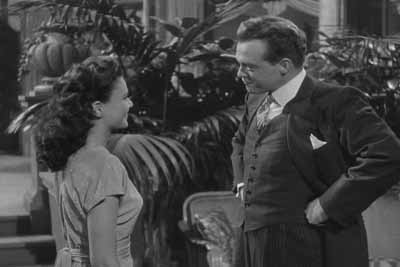
"You’ll be making Tolitamite babies in no time!"
Presented in the films original 1.33:1 aspect ratio, the look well, sometimes stinks into oblivion. I’m sure intensive care was put into salvaging the remaining elements, but there are several scenes where a series of ghosting white dots appears to bounce around on-screen, running horizontally around the frame and cause me to fume. After a while it disappears, and as a whole the rest of the image is fairly well presented, ranging from a variety of deep, dark colors and a good transfer.
6.0 out of 10
The Noise
The noise of Possessed is what helps make the film. In conjunction with the musical aspects of the film, Franz Waxman’s score helps us jump inside Louise’s psyche aurally, with the use of violins, dirty horns, and other music to achieve a relatively scary effect (I likened it to the levels of Hermann with Psycho). As she descends into her own madness, Waxman keeps bombarding us with his score, making you follow down with her. Presented in Dolby Digital 1.0 Mono, the sounds across the board are clear, crisp, and worthwhile. Waxman, the dialogue, and everything else in between are splendid.
9.0 out of 10
The Goodies
There’s a commentary by Film Historian Dr. Drew Casper, of USC’s Hitchcock school, who waxes very wonderfully about the history of the film and filmmaking in general. He’s incredibly informative, speaking about expressionism as it relates to the film, the documentary realism presented, Noir in relation to its golden age (1945-60), Noir’s seminal works, influences, and the social realism of the WB classical period. He’s got notes alongside his microphone, and you can hear him turn the pages quickly. However, his grandfatherly voice and his wealth of knowledge on each subject are quick to draw you in and make you stick around for a while.
There’s also a new featurette: Possessed: The Quintessential Film Noir (runtime 09:34) which interviews a variety of subjects (James Ursini, Casper, and Eddie Muller of filmnoir.com) on their thoughts of Possessed and how it fits into the film noir mold. Muller’s an interesting guy, having heard him speak during a Noir fest in LA months ago, so he’s got some informative tidbits to say. Most importantly, is the discussion on WB and their distinction of having women play the femme fatales in noir, the psychological themes present, and the popularization of Freud in regards to noir itself. Be forewarned, that this featurette contains SPOILERS (!!!), so don’t watch it until after seeing the film.
Finally, there’s a theatrical trailer (runtime: 02:06) that is spectacularly enthralling and gets you pumped about the film. How pumped? Fists are involved.
7.0 out of 10
The Artwork
The colors! The single-minded colors stand out against the painted faces of Heflin, looking rather devilish, and Crawford, red hair blazing like Jeffrey Tambor’s baldhead. The film’s title is larger than life, fitting since the movie is almost so. While it contains absolutely nothing about the film, it does sell it for Crawford fans. I kind of like it.
7.0 out of 10

 BUY IT AT AMAZON: CLICK HERE!
BUY IT AT AMAZON: CLICK HERE!
STUDIO: Metro-Goldwyn-Mayer
MSRP: $15.98 RATED: NR
RUNNING TIME: 133 Mins. (B&W With Technicolor Sequence)
SPECIAL FEATURES:
• Cast & Crew Information (text only)
• Behind-The-Scenes Information (text only)
• Scoring Sessions/Music Cues Of The Women (audio only)
• Alternate Fashion Sequence With Different Footage
• Short Film: “Hollywood: Style Center Of The World”
• Short Film: “From The Ends Of The Earth: Another Romance Of Celluloid”
• Theatrical Trailers For The Opposite Sex & The Women
Note! This DVD is part of The Joan Crawford Collection (buy the boxed set and save money from CHUD!) The Women (1939)
Putting together two notoriously famous women, Norma Shearer and Joan Crawford, was a masterstroke. It just so happened that they both despised each other, the feud extending back to Crawford’s days on the MGM lot in the late twenties. Jealousy of Shearer was to blame, and it would only get worse as Shearer was married to production head (and boy superhero/genius) Irving Thalberg. With famed ‘actor’s director’ George Cukor directing it all (just weeks after being unceremoniously fired from Gone With The Wind, take that Selznick!), and a bevy of catty women all around them, including the comedic relief Rosalind Russell, the stage was set for a most entertaining film by all reasonable standards.
Shearer plays Mary Haines, the cuckolded woman whom Crystal Allen (the bitchy Joan Crawford) has snatched away her husband. It just so happens that she finds out from Olga, the local manicurist at Syndey’s, a local salon. Word has gotten out beforehand, so it’s natural that all who travel in Haine’s social circle know of the transgression and squawk amongst themselves like the gossipy behemoths that they truly are. Syndey’s is a world of gossiping women and shifting alliances, wafting in the wind at any juicy bits thrown to the figurative lions getting their nails done, working out, or even taking mud baths. It’s only a matter of time before "Stephen Haines is stepping out on Mary", thus stepping into the relationship with Allen and her conniving, money-grubbing, meal ticket little ways.
Mary is a strong woman with a great motherly instinct. This shouldn’t have happened to her, after all, she has a lovely life and a saccharine filled time with Little Mary, her daughter. It seems perfect, but behind it all, there’s room from some naughty discretions courtesy of Stephen. When the news finally hits her, like a freight train of awfulness, it really blinds her, especially since her well-to-do husband is cheating with some perfume counter girl, intent on finding a hot meal ticket on the up-and-up! Shearer plays the wounded and vulnerable Mary to all of her strengths, against all of the situations the film stacks up against her. As she moves from shocked, to ultimate sadness, to confidence that she’ll win him back, and then back to heartbreak, before the ending, it allows Shearer to use her natural abilities as a stunningly beautiful actress to her own advantage.
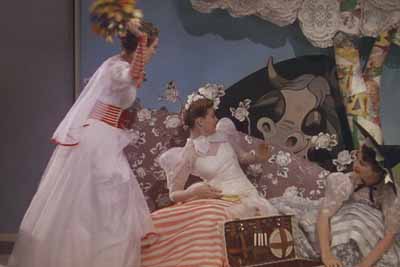
Susie’s Cock-and-Bull story had a lot of Bull, but was missing something… else.
As Allen keeps Stephen all to herself, causing a humongous rift between Mary and the reality of the situation, enter Mary’s Mother. Promptly informing her to stay quiet, shut up, and the situation will resolve itself, she represents the old ways of society in these types of horrors. But Mary’s a new type of woman, the 1930’s kind ("this is today!" she shouts, "we’re equals!"), and she’s confident that a trip away to Bermuda, all from everything, will solve all of her problems. Mary sends out her own arsenal (her friends, who include the lovely Paulette Goddard and the amazing Joan Fontaine) against the newly formed relationship while away, but there’s just failure and sadness. Coincidentally, it only gets worse as Stephen agrees to marry Crawford and dump Shearer in the way that only the good guys can understand. They all die young, as Mr. Joel mentioned. At least, that’s what they say.
Fed up with everything, Mary takes a respite against society on a train bound for a woman’s retreat area, the Double Bar T Ranch in Reno, NV. Coincidentally, when I respite against society, I go into downtown LA with Snake and a totally tubular surfing Peter Fonda. While there she meets the elderly dame Countess De Lave, the oft-married debutante who understands life and has been through a boatload of ups and downs with her husbands. De Lave takes Mary under her wing and teaches her all about life and what it entails, even though you get the feeling that Mary’s more of a headstrong woman than De Lave could ever be. She gets it more than De Lave does. Meanwhile, the recently married Crawford seems to be having some problems in the marriage and it hits quite the bump in the road with some unforeseen developments that send everything on its merry little way to the over-the-top conclusion. Speaking of that, I’m not satisfied with the ending of the film. I feel like it almost betrays certain character elements established throughout the entire narrative. I can clearly understand the time period in which the film was produced, but that still doesn’t mean they have to end it like they do. It’s extreme eye-rolling melodrama, coupled with flaring violins and smiles all around.
As Crystal Allen, Crawford gets one of her most selfish roles, one in which she fleshes out in all manners of bitchiness, false confidence, being lost in her own world styles of thinking/acting, and just being a genuine spit-fire, filled with scheming and plotting devices that would make any normal person’s head spin (or explode, if you’re into that type of thing). Perfectly cold and calculating, she’s terrifically awful, constantly throwing barbs between her confrontations with Shearer and the wittiness that transcends from that is the harmony that extends from the real-life situation of two actresses that perfectly loathe one another. As Gaspar Noé succinctly stated, time destroys everything, and it’s great fun to watch everything Crawford and Co. do what they do, all the way down to Allen’s Jungle Red-like send off, complete with the "in your FACE!" style of melodrama. Spectacular! Catty!
George Cukor keeps his eye on the ball and brings us one of his best pictures. He keeps the film light, airy, and constantly moving, allowing the characters to breathe and also be wary and understanding of specific actions that they encounter. Cukor appears to be taking the extreme delight in the general gossip thrown throughout lady-land (one need look no further than the stories of the off-color jokes and expletives he used to blurt out on sets), so it’s natural to see his glee come forth through his camera and imprint onto you. As an aside, there are absolutely no men in the film, and Cukor uses this to his advantage. However, in the verbal sense, men are all over this film, being mentioned every couple of seconds or so (the tagline being: It’s All About Men!). Additionally, working in Technicolor presents an interesting challenge to Cukor, because he only uses the bursting scene for the fashion show, which both Mary and Crystal attend. Tensions fly, but the clothes stay bright and airy, as Cukor allows the color to bleed through the B&W image book ending the parts and making the transition between the stark contrasts easy on the eyes, although a little jarring should you turn away, or blink. It’s a testament to Cukor’s abilities as a great director to keep the story moving at a brisk pace and never once descends into boredom or has you checking your watch. For an older film, it’s wonderful and spectacular all at once.
The Women is a great film and is always fun whenever I watch it.
9.0 out of 10
The Look
Presented in the film’s original 1.33:1 aspect ratio, the cinematography of both Oliver T. Marsh and Joseph Ruttenberg works amazing feats in both B&W and Technicolor. The B&W parts of the film (which constitute pretty much the entire film) have delicious blacks and subtle grays. Aside from a few image blemishes here to there (some scratching, some grainy noise), the look is almost crystal clear. As for the Technicolor sequence, it stands out as a triumph in an already wonderful film.
8.5 out of 10
The Noise
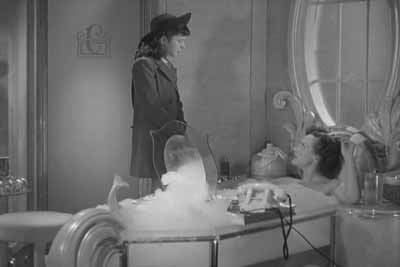
"Why can’t you people accept Devin’s Batman: Begins review?"
Presented in Dolby Digital 1.0 Mono sound, what you hear it easy on your ears, allowing the verbal foreplay to permeate your room and your black heart. It’s crisp and clean and really, really mean.
9.0 out of 10
The Goodies
Amazingly packed with a wealth of information (except no commentary):
First off, there’s Cast & Crew Information (text only), with Behind-the-scenes Information (text only, but does explain some of the back story of the film and its reception by audiences of the time).
Included is Scoring Sessions/Music Cues Of The Women (audio only, runtime approx. 42:00) that allows you to access the score from the various parts of the film you might wish to revisit, or hear for the first time. I suggest watching the film first.
An Alternate Fashion Sequence With Different Footage (runtime: 06:00) is also included, and it’s okay. Nothing special, and you can compare and contrast the differences between what was included and what was left out.
Next up is a short film entitled "Hollywood: Style Center Of The World" (runtime: 11:05), which is basically a publicity piece for MGM to parade out it’s cavalcade of stars (‘…more than in the heavens!’ – it states) and tout their own horn. Crawford does make an appearance, regarding film clips of hers for a film called Susan And God, where the direct correlation between what she wore in the film had an impact on women across the country. How did this happen? Well, the short states that Hollywood has infiltrated the country! And it’s going from door-to-door destroying your souls! (kidding!). Your typical fluff piece, it should be cool for film buffs to see for the nostalgic factor.
There’s also a short film called "From The Ends Of The Earth: Another Romance Of Celluloid" (runtime: 10:20), which is yet another publicity fluff piece regarding how costumes, materials, and props are brought from all over the world into Hollywood. MGM touts their extensive appetite for the destruction and demolition of all worldly materials, being proud of their depletion of the world’s natural resources, like coal, and attractive New Hampshire people. It does discuss The Women, and a bunch of other films (like the original Ben-Hur, Ninotchka, Northwest Passage, and The Marx Brothers at the Circus), so that’s neato to see it. Yes, I said neato.
Finally there’s two theatrical trailers. The first is the original theatrical trailer (runtime: 03:27), which brings home the point of the Broadway show, the women involved, and the femininity throughout the film. Next is the trailer for The Opposite Sex (runtime: 03:45), which is the re-make of The Women set against songs, dancing, and cleft jawed men from the ’50’s.
8.5 out of 10
The Artwork
Thankfully, this being a re-issue, Warner has dumped the infamously horrible snapper case and focused on an Amary case, much like every other film in the set. The artwork stays the same as the previous edition, only now it feels all sexy and sleek, just like Ron. The images of the three main women (Shearer, Crawford, and Russell) make the movie, and their happy-go-lucky seductive poses should entice anyone who loves older films. As for the rest, it should scare them away promptly into CHUD’s own MBs.
9.0 out of 10

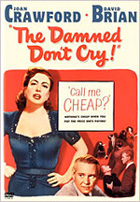 BUY IT AT AMAZON: CLICK HERE!
BUY IT AT AMAZON: CLICK HERE!
STUDIO: Warner Brothers
MSRP: $13.98 RATED: NR
RUNNING TIME: 103 Mins. (B&W)
SPECIAL FEATURES:
• Commentary By Director Vincent Sherman
• New Featurette: “The Crawford Formula: Real To Reel”
• Theatrical Trailer
Note! This DVD is part of The Joan Crawford Collection (buy the boxed set and save money from CHUD!)
The Damned Don’t Cry (1950)
A frumpy decaying body of notorious gangster Nick Prenta is discovered in the desert (if you live out west, say in Phoenix, this happens all the time). The clues lead the Police back to a woman named Lorna Hansen Forbes, who happens to also be known as Ethel Whitehead (no relation to Dan). Crawford is the dragon lady in the flesh, and she’s out in the world to escape the confines weighing her down. As it stands, we’ve got no idea what’s happening, so thanks to the wonderful device known as the flashback, we begin to understand what would cause a go-getting woman such as Crawford to flee the scene and take refuge with her parents. It’s not the cooking, or the homemade pants, I’ll tell you that.
Ethel’s always wanted to be somebody, but being stuck in a dead-end marriage with child has taken its toll. Life has beaten down on her for quite some time. When her child succumbs to vehicular manslaughter, she takes it as a sign to get out, and off she goes into the big city (not much time for mourning the loss of your spawn, you see). There, she discovers what it takes, the oophs and the aahs (sex!), to make it, no matter how many people you leave by the wayside (condoms!). As she progresses her way to the top, chewing men from left side to right before spitting them out, Ethel, the student, transforms into the master.

"Argonauts!"
As such, she gets involved with a gaming scheme in the back on her favorite restaurant. She’s in it for the fast buck it brings, and into her life comes Martin Blackford, C.P.A. At first she believes that an accountant pulls in the big bucks, so naturally she latches onto him. It’s later when she discovers that Blackford doesn’t make the pretty penny, so she does him a favor and has him look over the gaming operations books. It’s then where Blackford is sucked into the life of a notorious gaming racket, complete with wannabe Gangsters and larger-than-life men adjusting their crotches while curling their lips. Ethel, meanwhile, sets her sights on the head racketeer, one George Castleman, who happens to be running a legit operation, one that flat topped square jawed Nick Prenta is pissing away ever-so slightly.
As all of the characters get further involved in this imbroglio, tensions mount, eyes shift around, and emotions run high. Blackford wants out, but wants to make sure that Ethel comes with him. Ethel wants the pedigree that comes with being somebody, and thus transforms into Lorna Hansen Forbes, before agreeing to marry Castleman. On one condition, of course, that she infiltrate Prenta’s lair and send him the way of the Dodo. It’s only then can everything come to a screeching halt, especially after she starts falling for the mug (not the root beer). In the end, The Damned Don’t Cry is all about a woman who climbs a little too high to escape her own social squalor, only to be pulled down from all different directions.
Crawford’s portrayal of the social man climber Ethel/Lorna is one of her kitschy best. She starts out, broken, destroyed and utterly bored and becomes the high-society fast-talkin’ dame with the loud mouth and the chutzpah to prove it in no time at all, and it’s a notch in Crawford’s acting belt to accomplish this with a relative ease. As her character changes, everything around her changes, fashions, styles, speaking patterns, and of course, ways of acting, behaving, etc. As more experienced (read: old) as Crawford may be by this point (1950), she still knows how to wow ’em with her advanced tricks. She brings her choice attitude and unbridled passion into the fold of Ethel, and you’d swear for a moment that she’s recalling her own past (especially since Ethel’s climb almost mirrors her own). Even though it’s probably not true, Crawford’s portrayal screams of her base desires, to never have to regress into what she was, and as she takes a hold of what she’s given (i.e. her massive sex appeal and her grasp on it, using it for herself and against everyone), that it’s a masterstroke to enjoy and eat it all up.
Director Vincent Sherman brings a relative hard-nosed style to the proceedings, allowing for the film to speak in conjunction with Crawford’s incredibly strong willed performance. His use of close-ups is inspiring and really tells the story visually. Those are the certain types of shots I am constantly remembering. Working in conjunction with her and her focused ladder climbing ways, Sherman continually makes the story interesting, focused, and downright nasty fun in most parts. However, the score is a bit too melodramatic for the film itself, falling victim to the musical moody clues of doom (bum bum bum!) where it has to reinforce everything in an over-the-top way, leaving no room for your own imagination. Granted, all films were like this back then, but this one has a little extra then normal. Sherman works hard to make his picture a mighty fine achievement, and ultimately, I feel she succeeds. His lesser-known work in the Crawford oeuvre might not be as grand as Mildred Pierce, or as sophisticated as Humoresque, but it’s still entertaining and is enjoyable.

The Sarsgaard renders all victims helpless.
The Damned Don’t Cry is a fun noir that should keep you sufficiently entertained, whether or not you find Crawford’s complexion a little too Ghost reversal.
7.5 out of 10
The Look
For such an older film, you’ll get no complaints from me. It’s sharp and clear in most spots. I did notice a hint of another color, but it’s not that noticeable in the grand scheme of things. It could also be my eyes after watching all of the films so intensively. Dear God, I hope I am not blind. I have to finish this!
8.5 out of 10
The Noise
Presented, like the others, in Dolby Digital 1.0 Mono. Ah, Mono. Everyone’s friend, showing up at parties, flashing its sex appeal when wearing dresses for the men nearby. It certainly knows how to use its charm. The mono is a saucy minx, and all I can say is that the sound is great.
9.0 out of 10
The Goodies
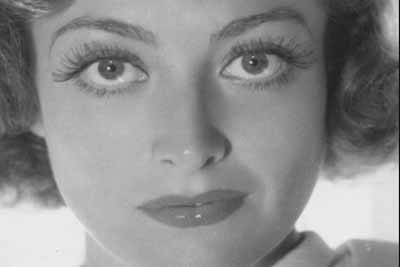
GARTH: Extreme Close-Up! Whaaaaaaaa!
Included on the disc is a commentary by director Vincent Sherman. He’s great, for a 98-year old man (hopefully I’ll manage to cheat death that way as well, fingers crossed!). He’s clear, concise, has some great anecdotes, talks at length about what went on to get certain scenes and is generally sharp as a tack. If old people frighten you, then you might wish to skip this one (please don’t!), lest Max Von Sydow hear your calls.
Next is a new featurette: The Crawford Formula: Real and Reel (runtime: 13:25), which discusses Crawford’s status in life and in the film at brief. Dr. Drew Casper makes his appearance, and has some informative things to say. It’s relatively short, but gives you a tiny insight into the type of character Crawford plays and how she used her status to her advantage.
Finally, there’s the theatrical trailer (runtime: 02:13), which is very sexy and a little naughty. The voice over is smile inducing. Not bad.
7.0 out of 10
The Artwork
Probably my favorite cover in the whole boxed armada. There’s just something electric about Crawford’s stance, and reminds me of a good friend I know. I think it works in telling you about the character, the film, and the text drives everything home. Very wonderful!
9.0 out of 10
Community Activity
| Discussion | Recent Posts |
|---|